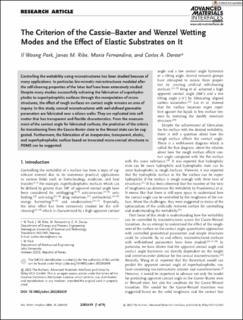The Criterion of the Cassie–Baxter and Wenzel Wetting Modes and the Effect of Elastic Substrates on It
Peer reviewed, Journal article
Published version
Permanent lenke
https://hdl.handle.net/11250/3093415Utgivelsesdato
2023Metadata
Vis full innførselSamlinger
Sammendrag
Controlling the wettability using microstructures has been studied because of many applications. In particular, bio-mimetic microstructures modeled after the self-cleaning properties of the lotus leaf have been extensively studied. Despite many studies successfully achieving the fabrication of superhydrophobic to superhydrophilic surfaces through the manipulation of microstructures, the effect of rough surfaces on contact angle remains an area of inquiry. In this study, conical microstructures with well-defined geometric parameters are fabricated over a silicon wafer. They are replicated into soft matter that has transparent and flexible characteristics. From the measurement of the contact angle for fabricated surfaces, the prediction of the criteria for transitioning from the Cassie-Baxter state to the Wenzel state can be suggested. Furthermore, the fabrication of an inexpensive, transparent, elastic, and superhydrophobic surface based on truncated micro-conical structures in PDMS can be suggested.

